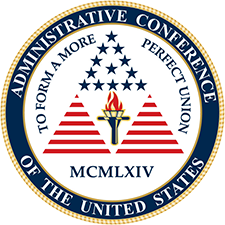NRC's formal adjudications -- which are presided over by ALJs or Atomic Safety Licensing Boards (as required by statute or regulation, or as directed by Commission) -- are conducted primarily under Subpart G of Part 2 (Title 10). NRC formal adjudications include: (1) NRC enforcement actions under Atomic Energy Act (unless the parties jointly agree to use a more informal proceedings); (2) initial licensing of uranium facilities; and, (3) portions of nuclear power plant licensing proceedings in which the presiding officer determines that resolution of contested matters or contentions require resolution of material facts, eyewitness credibility, motive or credibility issues, or other similar issues; and (4) portions of nuclear power plant licensing proceedings in which the presiding officer determines that resolution of contested matters or contentions require resolution of material facts, eyewitness credibility, motive or credibility issues, or other similar issues. The Commission is assisted in its appellate review by the Office of Commission Appellate Adjudication.
Agency:
Scheme Nickname:
Formal adjudication under Subpart G
Comments/Notes on Adjudication Structure:
In 2004, NRC promulgated revised rules for its "main" adjudication schemes that substantially revised its rules of practice to make them less procedurally formal. NRC stated that its experience showed that "in most instances, the use of the full panoply of formal trial-like adjudicatory procedures ... is not essential to the development of an adequate hearing record." 69 Fed. Reg. 2182, 2182 (Jan. 14, 2004); see also 77 Fed. reg. 46,562 (Aug. 3, 2012). NRC departed from its long-standing agency interpretation that the Atomic Energy Act (AEA) required on-the-record (APA) hearings, and greatly narrowed the jurisdictional scope of this formal adjudication scheme. For this formal scheme, either ALJs or the Atomic Safety Licensing Board (ASLB) preside over discovery (with rules patterned largely after FRCP 26) and and evidentiary hearings. (Section 191 of the AEA, authorizes NRC to use 3-member ASLBs (or, on occasion, individual presiding officers) -- staffed by NRC administrative judges -- in lieu of ALJs for agency hearings under the AEA.)
*Note: At the appellate level, this scheme includes review by the Commission of written initial decisions issued by NRC presiding officers (other than Commission members) -- primarily Atomic Safety and Licensing Board panels -- relating to a variety program-related areas and hearing tracks (e.g., Part 2/Subparts C, G, J, L & N), as well as several non-program areas for which appeals are available. These non-program areas are: (1) non-discrimination in federally-assisted programs under Title VI, section 504 of the Rehabilitation Act, Age Discrimination Act, and Title IX (10 CFR Parts 4 & 5); (2) and, civil penalties under the Program Fraud Civil Remedies Act (10 CFR Part 13).
Types of Adjudication:
Type A
Type B
Comments/Notes on Adjudication Type(s):
NEH regulations do not specify the official who serves as the "hearing official," other than noting that such person "may not be under the supervision or control of the [NEH] Chairperson[.]" (45 CFR 1179.2; see also 45 CFR 1179.5(b)). Some federal agencies use ALJs for administrative sanction proceedings, including salary offsets, though it is not clear if such use is required by statute or at agency discretion.
Resources & Articles:
Final Rules Revising Adjudication Rules: 69 Fed. Reg. 2182 (Jan. 14, 2004)
Amendments to Adjudication Process Rules: 77 Fed. Reg. 46,562 (Aug. 3, 2012)
Citizens Awareness Network v NRC, 391 F.3d 338 (Dec. 10, 2004)
Chevron and Hearing Rights: An Unintended Combination, 61 Admin. L. Rev. 249 (2009)
NRC Blog on History of ASLB: http://public-blog.nrc-gateway.gov/tag/atomic-energy-act/
NRC ASLB Panel Responsibilities: http://www.nrc.gov/about-nrc/regulatory/adjudicatory/aslbp-respons.html
Commission Adjudicatory Responsibilities: http://www.nrc.gov/about-nrc/regulatory/adjudicatory/commission-respons.html
Distinctive Features:
*Controversial revisions to adjudication rules in 2004 had three notable features: (1) NRC changed long-held view that AEA required APA-style hearings; (2) final rules created a complex reg multi-track adjudication system with varying levels of procedural formality and availability of discovery mechanisms; and (3) end result that most adjudications now conducted as informal proceedings. (Note that this scheme only covers the now-narrowed formal adjudications; informal proceedings covered under other scheme codes, primarily ACUS Scheme Code NRCOSUBL.) NRC stated that its intent in revising its adjudication rules was to reduce litigation burdens and increase efficiency. Public interest groups and citizen commenters greatly opposed the rule changes, while nuclear industry commenters uniformly supported. Subsequent legal challenges to the procedural deformalization in the 2004 final rule were rejected. See Citizens Awareness Network v. NRC, 391 F.3d 338 (1st Cir. 2004).
* Public Participation: 2004 rules permit public to file "contentions" to participate (or initiate) adjudication of license or permit applications, but requirements very strict. Akin to strict standing requirements in federal court.
Other Comments:
The AEA establishes a unique process whereby 3-member panels (or, occasionally, individual presiding officers) from the Atomic Safety Licensing Board (ASLB) are convened by the Commission to adjudicate specific cases, and each ASLB panel must have one administrative judge with an expertise in administrative law, and two administrative judges who are technical or scientific experts. The ASLB has no fixed number of positions and is composed of lawyers (full or part-time), scientists, and engineers.
Verified by Agency:
Not verified
Is this a Major Adjudication:
Yes
